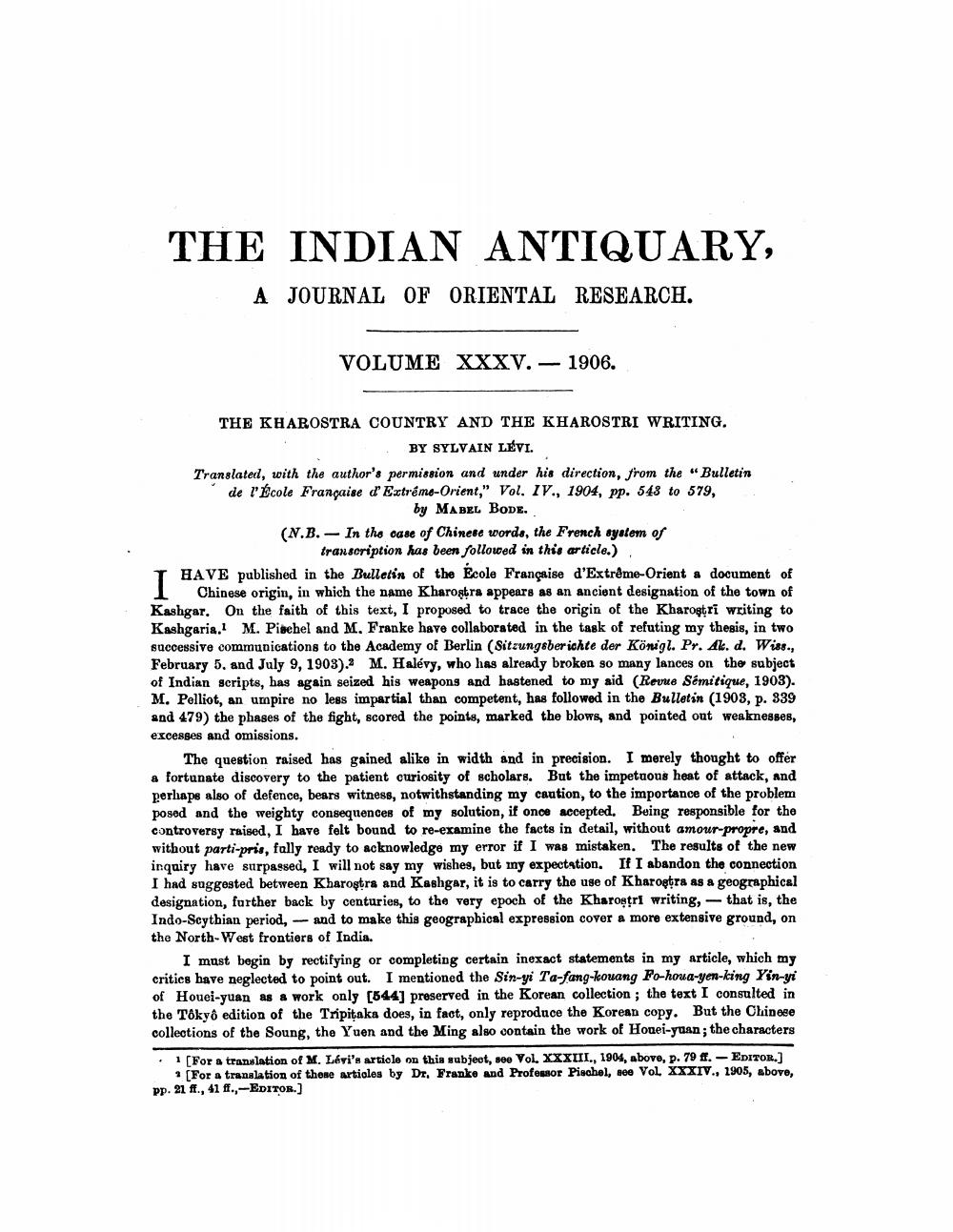________________
THE INDIAN ANTIQUARY,
A JOURNAL OF ORIENTAL RESEARCH.
VOLUME XXXV. – 1906.
THE KHAROSTRA COUNTRY AND THE KHAROSTRI WRITING.
BY SYLVAIN LÉVI. Translated, with the author's permission and under his direction, from the "Bulletin de l'École Française d'Extrême-Orient," Vol. IV., 1904, pp. 543 to 579,
by Mabel BODE. (N.B. - In the oase of Chinese words, the French system of
transcription has been followed in this article.) T HAVE published in the Bulletin of the Ecole Française d'Extrême-Orient a document of 1 Chinese origin, in which the name Kharostra appears as an ancient designation of the town of Kashgar. On the faith of this text, I proposed to trace the origin of the Kharoştri writing to Kashgaria. M. Pinehel and M. Franke have collaborated in the task of refuting my thesis, in two successive communications to the Academy of Berlin (Sitzungsberichte der Königl. Pr. Al. d. Wiss., February 5, and July 9, 1903). M. Halévy, who has already broken so many lances on the subject of Indian scripts, has again seized his weapons and hastened to my sid (Revue Sémitique, 1903). M, Pelliot, an umpire no less impartial than competent, has followed in the Bulletin (1908, p. 839 and 479) the phases of the fight, scored the points, marked the blows, and pointed out weaknesses, excesses and omissions.
The question raised has gained alike in width and in precision. I merely thought to offer a fortunate discovery to the patient curiosity of scholars. But the impetaous heat of attack, and perhaps also of defence, bears witness, notwithstanding my caution, to the importance of the problem posed and the weighty consequences of my solution, if once accepted. Being responsible for the controversy raised, I have felt bound to re-examine the facts in detail, without amour-propre, and without parti-pris, fally ready to acknowledge my error if I was mistaken. The results of the new inquiry have surpassed, I will not say my wishes, but my expectation. If I abandon the connection I had suggested between Kharoştra and Kashgar, it is to carry the use of Kharo tra as a geographical designation, further back by centuries, to the very epoch of the Kharoştri writing, - that is, the Indo-Scythian period, and to make this geographical expression cover a more extensive ground, on the North-West frontiers of India.
I must begin by rectifying or completing certain inexact statements in my article, which my critics have neglected to point out. I mentioned the Sin-yi Ta-fang-houang Fo-houa-yen-king Yin-yi of Houei-yuan as a work only (544] preserved in the Korean collection; the text I consulted in the Tokyo edition of the Tripitaka does, in fact, only reproduce the Korean copy. But the Chinese collections of the Soung, the Yuen and the Ming also contain the work of Houei-yuan; the characters
• 1 [For a translation of M. Lévi's artiole on this subjeot, see Vol. XXXIII., 1904, above, p. 79 f.- EDITOR.]
[For a translation of those artioles by Dr. Franke and Professor Pischel, see Vol. XXXIV., 1905, above, Pp. 21 ff., 41 ff.,-EDITOR.]




